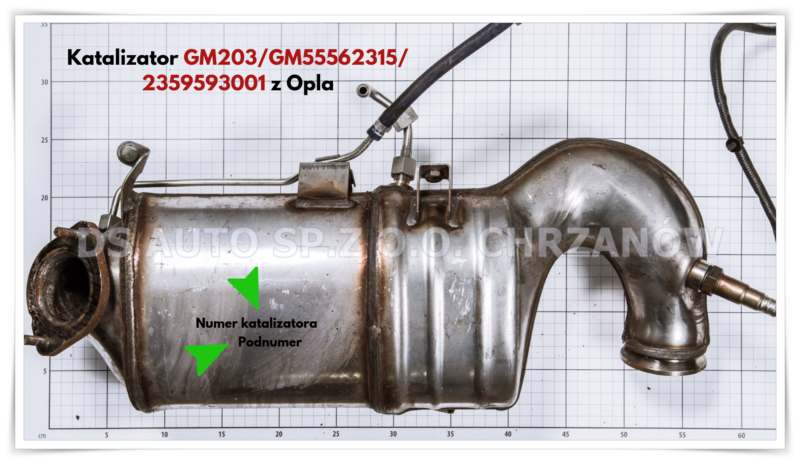Catalysts with the number GM203/GM55562315/2359593001 they are characterized by considerable sizes. Their length is about 60 cm, and the weight of the insert is just over 3.2 kg. Its shape is also unusual, which consists of several different shapes. The main stem consists of two parts, one of which is completely smooth, and the other has three transverse stripes. The banks are flattened. These catalysts have a ceramic insert and are dedicated to cars with a diesel engine. They were mounted on the model Opel Insignia 2.0 CDTI, and SAAB 9-5 2.0 TID from 2010. Manufactured by Ismeretlen.

Opel Insignia is a middle class car, produced by the German brand Opel since 2008, thus replacing the Opel Vectra model. It was first presented at a London car dealership that same year.
The Insignia was created to compete with such leading global models as Peugeot 508, Ford Mondeo, Citroen C5, Audi A4, BMW 3 Series and Volkswagen Passat.
The Insignia is a five-seater front-facing vehicle that is offered with front-wheel drive and four-wheel drive. He opens the General Motors Epsilon II platform, which was later used by several passenger cars of segments D and E of the mentioned industrial group, which was released in the years 2009–2011, such as the Chevrolet Impala and Saab 9-5 .
In continental Europe, sold under the Opel brand, in Great Britain traditionally under the Vauxhall brand, and in China as Buick. Imports to Australia and New Zealand were made under the name Holden. The Insignia was also the name of the Opel concept in 2003, but it has nothing to do with the new Insignia.
Insignia is the first car to be produced with a system that connects the camera to the recognition of road signs. Offers 3 cm more knee space than Vectra. Both body variants have the same length of 4830 mm and the same wheelbase of 2727 mm.
The car has been offered since October 2008 with nine engines: 1.6-liter gasoline 115 HP, 1.8-liter 140 HP, 1.6-liter 180 HP, 2.0-liter with direct turbocharging 220 HP and four 2.0 – liter CDTi I4 diesel engines, three with 110, 130 and 160 HP and two with 190 HP. The flagship model has a 2.8-liter turbocharged V6 gasoline engine with 260 horsepower.
All engines meet the stringent Euro 5 emission standards and are equipped with a 6-speed manual and automatic transmission.
Insignia won the prestigious title of Car of the Year 2009, awarded by a committee of journalists from the European automotive press, in which he beat Ford Fiest by one point.
The biggest advantages of using the model are high economy, liveliness, a spacious trunk, and the seats are extremely comfortable, which means that even driving on long routes is not tiring. The automatic transmission works perfectly and was also used in production BMW Series 2 and some Volvo models. The engine provides good dynamics when driving on the highway. The drive on both axles makes it great even on slippery surfaces. The body is well protected against corrosion.
The biggest disadvantages: Plastics for finishing the car are hard and not very pleasant to the touch. The failure of electronics spoils the whole image of the model. In addition, some parts are only available from an Authorized Service Center. A possible repair can be expensive.

 Phone number:
Phone number:  E-mail:
E-mail:  A stationary point:
A stationary point:  Getting from the customer:
Getting from the customer:  XRF analysis spectrometer:
XRF analysis spectrometer:  Valuation by numbers:
Valuation by numbers: 